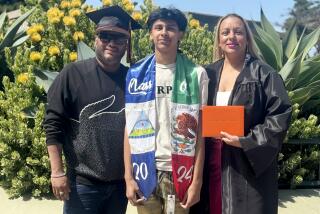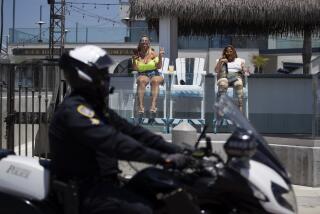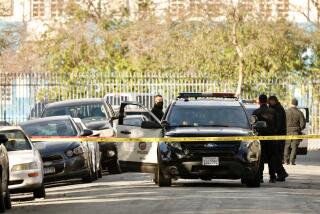Fatal Bar Shooting Shatters Peace in Tiny Sierra Madre
- Share via
The drone of a circling police helicopter woke many people in Sierra Madre in the black of a recent August night.
Problem in nearby Pasadena, one man thought. Traffic accident, thought another. But darned if that noise didn’t sound as if it were directly overhead.
Must be a fire, thought Sierra Madre Mayor Doug Hayes. He pulled himself out of bed, stepped barefoot into his car and drove downtown toward the chopper’s searchlights.
There he found the Tailgators sports bar roped off with yellow police tape. Blood splattered the sidewalk and five bullet holes chipped the bar’s stucco wall. Hayes quickly learned that one man had been shot dead, that another man was being held and that police were seeking a third man who had fled on foot.
For tiny Sierra Madre, 17 miles northeast of Los Angeles, it was the first fatal shooting in 14 years.
“Something like that, for crying out loud, is never supposed to happen here,” said Hayes, 51, whose eyes filled with tears. “We’re not used to dealing with anything wilder than an out-of-control skateboarder.”
Sierra Madre is among the last small towns in Los Angeles County. Residents like to say that if someone sneezes while walking past Howie’s Market, by the time he reaches Arnold’s Hardware store, owner Bob Hatfield will ask: “How’s your cold?”
A local newspaper once ran a front-page headline that blared: “A Week of Tragedy in Sierra Madre.” The story described a minor traffic accident and how some kids had put detergent in a koi pond, killing the fish. Because of this small-town intimacy, many locals refer to Sierra Madre as Mayberry, after the squeaky-clean town in the 1960s TV series, “The Andy Griffith Show.”
But in the early morning hours of Aug. 8, a big-city crime hit George Lopez’s Tailgators sports bar. Lopez arrived at his bar at 11:30 p.m. on Aug. 7, a Wednesday. Three men walked in soon after. He’d never seen them before. That was unusual. At Tailgators, most of the patrons are townspeople or buddies of Lopez.
In Sierra Madre, George Lopez--like many here--is known by his first name. Lopez, 42, retired from the Los Angeles Police Department last year. He had been a cop for 20 years, working a variety of assignments, including undercover narcotics and SWAT, before deciding he’d had enough. He was fed up with the politics and the lousy reputation he felt police had gotten after the beating of Rodney King. A couple of bad officers, he said, shouldn’t taint the entire department.
When he left the LAPD, he hoped to make a living running his restaurant and sports bar. He believed his enterprise would be more profitable if he worked full time, rather than squeezing in time between shifts. He also wanted more time with his wife and their two sons. One Christmas, wanting his boys to learn compassion, he and his family distributed several hundred dinners, cooked at his restaurant, to the homeless in downtown Los Angeles.
Experience told Lopez that the three strangers were casing his bar. Uneasy, he asked a bartender to check the bathroom. The bartender walked in just as one of the three strangers punched a patron, Lopez said. After that, the three men headed for the front door. Lopez said he followed.
“I wanted to make sure they were going,” he said.
Just outside the front door, standing a few feet away, one of the men pulled out a gun, Lopez said, and pointed it at Lopez, then at Lopez’s friend, an off-duty LAPD officer.
As the gunman aimed again at Lopez, the off-duty officer drew a weapon and the two exchanged fire.
Lopez had always prided himself on being prepared. But suddenly, he recalled, “I’m a retired officer without a gun in a gunfight.”
In his 20-year police career, Lopez said, he had never shot anyone. Now he wanted a gun in the worst way, and it was inside the bar.
When the shooting was over, one of the strangers, John Lamar Chavez, a 34-year-old Duarte resident, lay fatally wounded on the sidewalk holding a .22-caliber semiautomatic handgun. Lopez and his friends subdued another member of the trio. The third man took off running. Sierra Madre police arrived, but they do not handle homicides; L.A. County sheriff’s deputies were called in.
“Having worked undercover narcotics and SWAT and I come to Mayberry, and here I have a gun pointed at me,” Lopez remembers thinking. “Wow, that’s a trip.”
Lopez said he has since lost a bartender and a DJ, both unnerved by the shooting.
Sierra Madre, with a population of nearly 11,000, is the third-safest city in the state, ranking behind Hillsborough in Northern California and San Marino, according to an FBI report. The city’s 18 police officers face an average of seven thefts and five burglaries a month.
More often, residents call police when they are locked out of their homes or when the neighbor’s dog is barking. A Sierra Madre officer last fired a gun in 1996 when pursuing a fleeing robber. He missed, but the suspect was caught anyway.
“It’s real quiet, and we like it that way,” said Sierra Madre Police Chief Wayne Bailey.
Minutes after the gunfire at Tailgators, phones at the police station began ringing: Were those gunshots? What’s the deal with the helicopters?
Joni Conlon, 39, a hairstylist who lives a block from the bar, was awakened by flashing lights. Eighteen years in Sierra Madre and she couldn’t remember anything like this.
Conlon panicked after the police dispatcher told her about the shooting and the search for a man who ran from the bar. Were her windows and doors locked? she wondered.
At 4 a.m., Conlon, mother of a 2-year-old, called police again. She told them her husband, whose job is exercising horses, was leaving for work and should not be mistaken for the wanted man.
Later that morning, when Bob Hatfield’s son-in-law, Mitch Schwartz, arrived to open the hardware store, there was still blood on the sidewalk.
Schwartz and his wife, Susan, live in Tel Aviv but were in Sierra Madre visiting family. Citing the violence in Israel, they said, most friends and relatives were trying to dissuade them from returning.
The couple had just returned from Las Vegas, where there had also been a shooting. That had not surprised them, but now, a homicide in Sierra Madre, where Susan had grown up?
Word of the shooting spread quickly.
Arlene Decker Jones, 77, heard about the incident the way most people did--through telephone calls with friends. One friend phoned and complained about the noise from the helicopters. Jones phoned another friend, who told her about the killing.
“ ‘No, not here, not Sierra Madre,’ ” Jones recalls saying.
Jan Reed, former editor of a town newspaper, heard the police helicopter as she went to bed. When she awoke later in the morning and still heard the helicopter, she figured something had gone awry in Pasadena. A local reporter phoned Reed, 73, around 9 a.m. to ask about the shooting.
Reed--propelled by curiosity--grabbed her camera, jumped into her pickup truck and drove to the crime scene.
No ma’am, an officer told her, she could not come inside the yellow police tape to take pictures.
Reed had one question: Was George OK? Yes, she was told. She said Lopez had catered her daughter’s wedding and she had always liked him.
Later, Reed explained, most people found it reassuring that neither the shooter nor the victim was from Sierra Madre. “Everyone will say, ‘It was someone outside our town,’ ” Reed said. “A Sierra Madran didn’t shoot a Sierra Madran.”
That was small consolation, said the mayor.
“Reality hit home that morning, that we are a town like any other,” Hayes said, “and bad things happen.”
More to Read
Sign up for Essential California
The most important California stories and recommendations in your inbox every morning.
You may occasionally receive promotional content from the Los Angeles Times.










